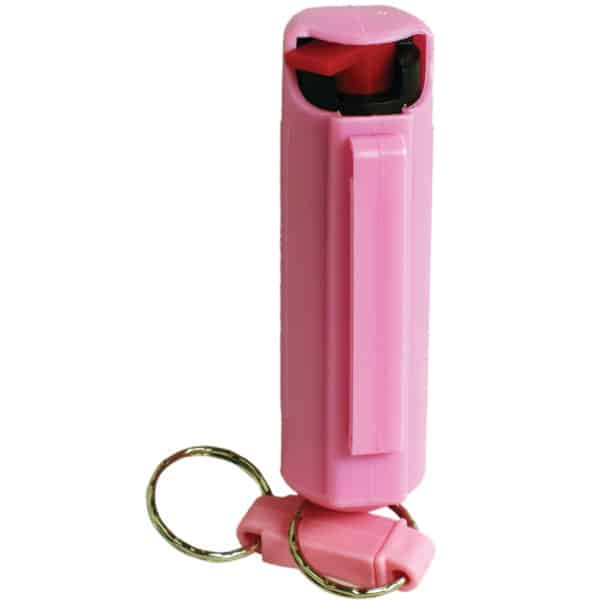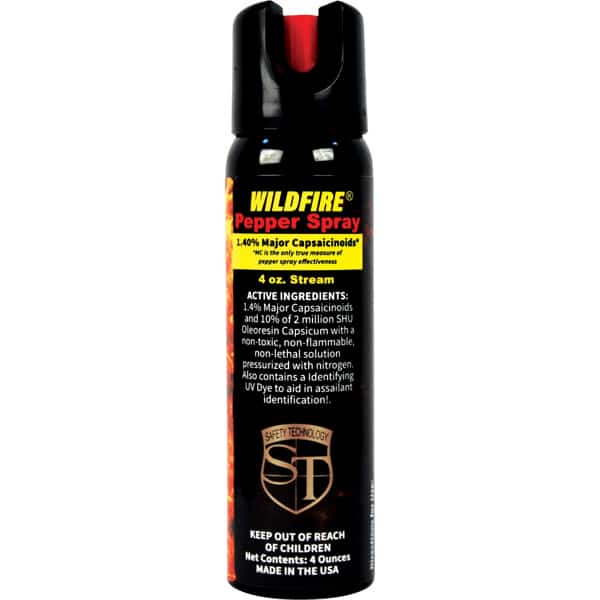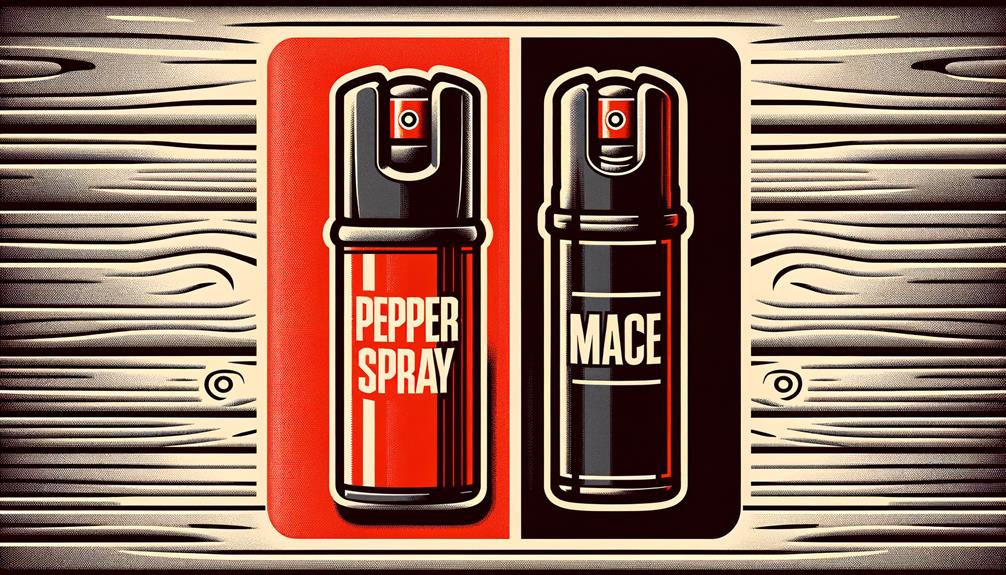
Brainstorm Security Shop

For Orders Over $199

On Any Of Our Products

Details On Refund Page
When considering the choice between pepper spray vs mace or your personal safety, understanding the nuances between these two self-defense tools is crucial. While both serve the purpose of deterring potential threats, the differences in their ingredients, effects, and practical applications can significantly impact their effectiveness in real-life situations. Before making a decision on which option to carry for self-protection, it’s essential to delve deeper into their distinct qualities and implications.
Pepper spray and Mace differ in their key ingredients, leading to variations in effectiveness and application. The chemical composition of pepper spray mainly consists of oleoresin capsicum (OC), a derivative of hot peppers. OC is the active ingredient responsible for the intense burning sensation, temporary blindness, and difficulty breathing upon contact with the eyes, nose, and throat. This inflammatory response incapacitates an attacker, providing the victim with an opportunity to escape.

On the other hand, Mace typically contains phenacyl chloride or CN, which is an irritant affecting the eyes and respiratory system. CN is the active ingredient in Mace that causes tearing, burning, and disorientation.
While both OC and CN serve the purpose of subduing an assailant, OC is generally considered more effective due to its potency and rapid onset of symptoms. Additionally, the chemical composition of pepper spray allows for quicker absorption into the skin, enhancing its overall effectiveness in self-defense situations.
When comparing the effectiveness of pepper spray and Mace in self-defense situations, it’s essential to consider their active ingredients and impact on incapacitating an attacker. Pepper spray typically contains oleoresin capsicum (OC), a substance derived from chili peppers, which causes intense burning and temporary blindness. On the other hand, Mace often includes tear gas or UV dye, which can cause respiratory issues and staining, respectively. In terms of strength comparison, pepper spray is generally considered to be more potent than Mace due to the higher concentration of OC.
Regarding safety concerns, both pepper spray and Mace can cause adverse reactions if not used properly, such as skin irritation or breathing difficulties. Additionally, the environmental impact of these products should be taken into account, especially in enclosed spaces or windy conditions where the spray can affect unintended targets.
In emergency situations, both pepper spray and Mace can be effective tools for self-defense. However, it’s crucial to weigh their pros and cons, considering factors like ease of use, potential legal implications, and the specific threat faced.
To comprehend the differences between pepper spray and Mace, it’s crucial to understand their respective range capabilities and spray patterns.
Coverage distance refers to how far the spray can reach, with pepper spray typically having a range of 6-12 feet and Mace having a slightly longer range due to its chemical composition.
Wind resistance plays a significant role in determining the effectiveness of these products outdoors, affecting how accurately the spray can reach the intended target.
Target accuracy is essential for ensuring that the spray hits the intended individual or animal. Pepper spray often provides better accuracy due to its finer mist, while Mace may have a more dispersed spray pattern.
Spray dispersion refers to how widely the spray disperses upon release. Pepper spray is known for creating a fog-like cloud, covering a larger area, while Mace tends to create a more targeted stream.
Understanding these factors can help you make an informed decision based on your specific needs and circumstances.
Understanding the potential health effects of pepper spray and Mace is crucial for making informed decisions regarding their use in self-defense situations. When exposed to pepper spray or Mace, individuals may experience immediate reactions such as intense burning, stinging, and temporary blindness. These effects are typically short-lived but can be distressing.
In some cases, individuals with underlying health conditions like asthma may experience exacerbated symptoms when exposed to these substances. Furthermore, there’s concern about the long-term effects of repeated exposure to pepper spray and Mace. While research on this topic is limited, some studies suggest that prolonged use may lead to respiratory issues or skin irritation.
It’s essential to weigh the immediate benefits of using these products for self-defense against the potential long-term consequences on your health. It’s advisable to use them judiciously and consider alternatives if you have pre-existing health conditions that may be aggravated by exposure to pepper spray or Mace.
Legal restrictions and considerations surrounding the use of pepper spray and Mace vary by jurisdiction and should be thoroughly researched before purchasing or carrying these self-defense tools. Understanding the legal implications is crucial to ensure you’re within the bounds of the law when carrying these products. Some areas have specific regulations regarding the concentration of active ingredients, size of the canister, and who can purchase or carry them. User safety is paramount; being knowledgeable about how to properly use these self-defense tools is essential to prevent accidental harm.
Public perception can also influence the legal framework surrounding pepper spray and Mace. In some places, there may be restrictions due to concerns about misuse or over-reliance on these products. However, these tools can also provide a sense of personal protection, especially for individuals who may feel vulnerable in certain situations.
Balancing legal requirements with the need for personal safety is key when considering the use of pepper spray or Mace.
Practical application of pepper spray and Mace differs in terms of their range and effectiveness in self-defense situations. Pepper spray typically has a range of 10-12 feet, making it suitable for use at a distance, while Mace, containing tear gas or UV dye, can be effective within 6-12 feet.

In real-life scenarios, the longer range of pepper spray may provide an advantage in deterring an attacker before they get too close. However, Mace’s additional components like tear gas can cause temporary discomfort, aiding in immobilizing the assailant.
Training techniques are crucial for both pepper spray and Mace. Proper training ensures users understand how to effectively deploy the product, aim accurately, and handle it safely. In real-life scenarios, this training can make a significant difference in how well the product serves its purpose.
Knowing when and how to use pepper spray or Mace can prevent potential harm and increase the chances of a successful self-defense encounter.
To determine the most suitable self-defense product for your needs, consider your comfort level with handling and deploying pepper spray or Mace. When comparing these products, think about your personal preferences and how they align with the characteristics of each option.
Pepper spray is known for its inflammatory properties, causing temporary blindness and intense burning sensations. On the other hand, Mace typically contains tear gas or UV dye additives, offering a different set of effects.
Safety features are crucial when choosing between pepper spray and Mace. Pepper spray often comes in canisters with a safety lock to prevent accidental discharge, while Mace may have a flip-top safety cap for easy access.
User experience plays a significant role in the effectiveness of these self-defense products. Some individuals find pepper spray easier to aim accurately due to its stream or cone spray patterns, while others prefer Mace’s fogger spray for wider coverage.
Ultimately, the decision between pepper spray and Mace hinges on your comfort level, personal preferences, and the specific safety features and user experiences each product offers.

In conclusion, when considering pepper spray vs. Mace, it’s important to weigh the differences in ingredients, effectiveness, range, potential health effects, legal restrictions, and practical use.
Pepper spray’s OC content makes it more potent and quickly incapacitating, while Mace’s CN formulation causes disorientation and burning.
Ultimately, choosing the right self-defense tool depends on your personal preferences, needs, and understanding of each product’s strengths and considerations.
Make an informed decision to ensure your safety in any situation

Brainstorm Security Shop
1867 Caravan Trail
Ste 105
Jacksonville, FL 32216
Call us toll free: (800) 859-5566